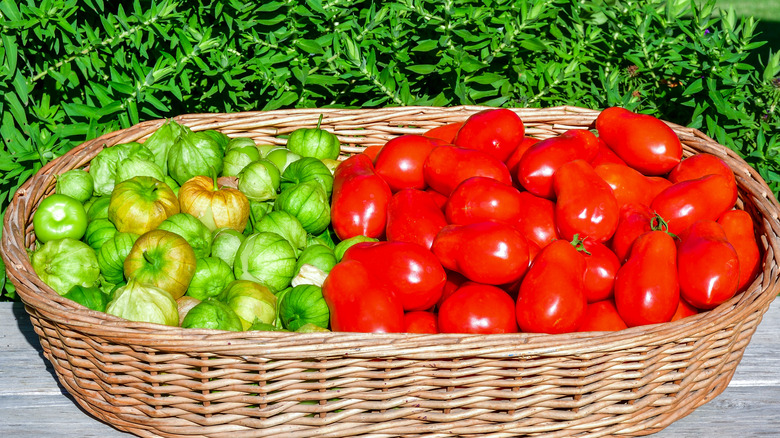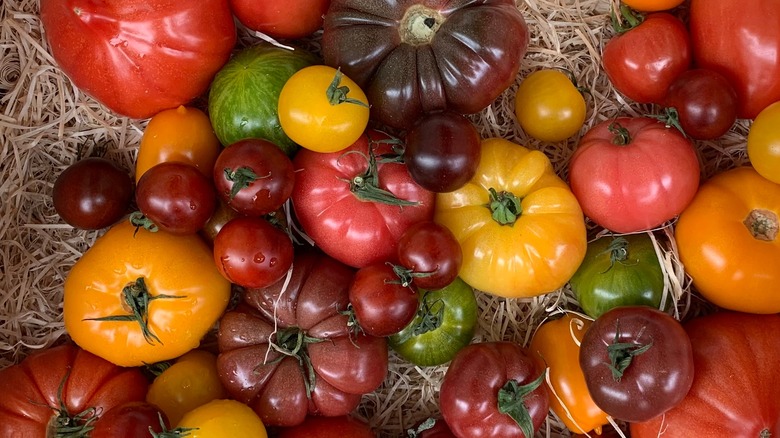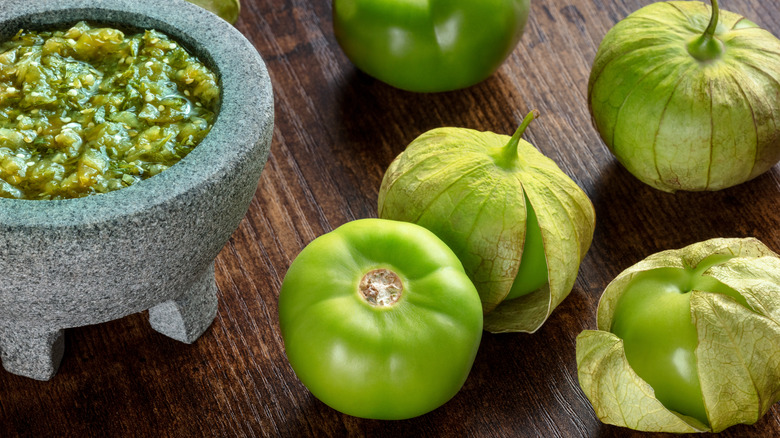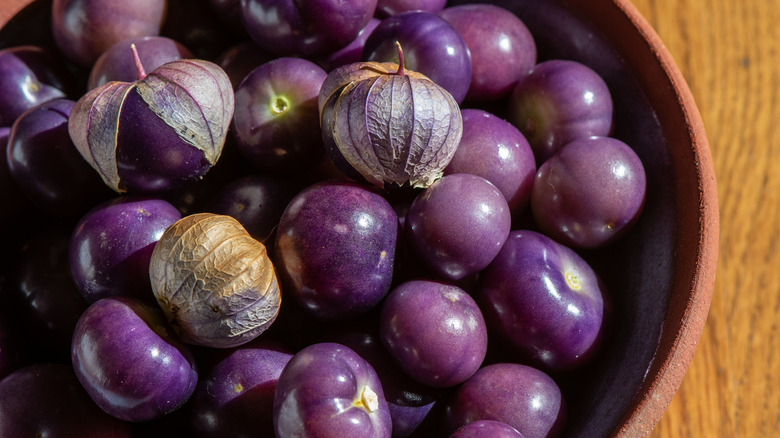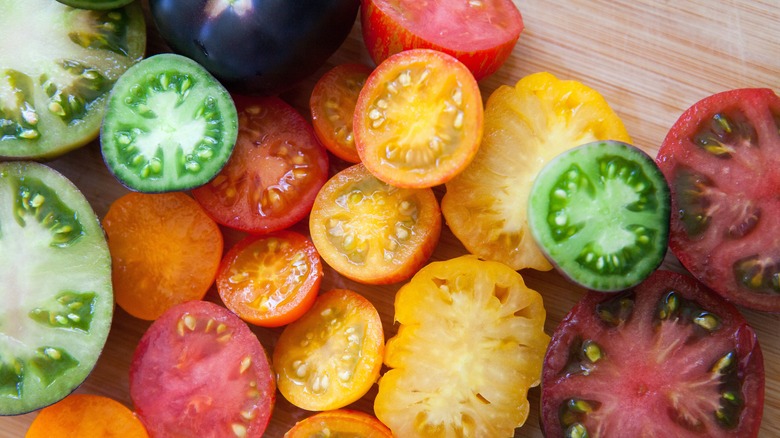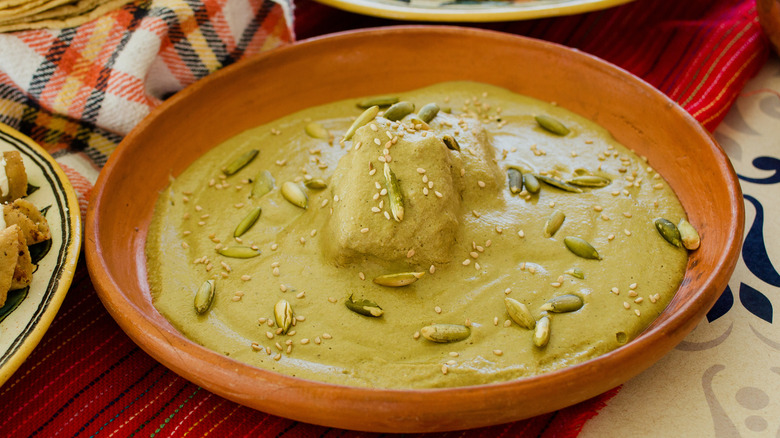The Differences You Should Know Between Tomatoes And Tomatillos
You say to-MAY-to, I say to-MA-to, but how do you say tomatillo, and what are they? Are they green tomatoes? How do they taste, where do you find them, and how are they different from regular tomatoes? There are many questions and misconceptions about the relationship between these two fruits. While they have a few things in common, they are very different from one another, particularly in flavor, texture, and variety. And by the way, it is pronounced to-ma-tee-YO.
Both species are native to the Americas and belong to the Solanaceae plant family (commonly known as nightshades), which contains over 2,000 species including potatoes, eggplant, chilies and sweet peppers, tobacco, goji berries, and several ornamental and medicinal plants. Tomatoes and tomatillos are the fruits of their respective plants, and fruits produced by nightshades are botanically classified as berries. Tomatoes (Solanum lycopersicum) and tomatillos (Physalis ixocarpa), alongside their spicy chili cousins, were used by ancient civilizations in Mesoamerica, in recipes that are direct ancestors to the salsas and moles we now know and love. While tomatoes eventually were accepted and integrated into cuisines around the globe, tomatillos are still mostly used in Mexican recipes, and are less widely available.
What are tomatoes and where did they come from?
Perhaps the best-known, most widely used member of the nightshade family, tomatoes are very familiar to most of us, despite there being over 10,000 varieties of this edible seeded fruit. From small, sweet cherry, celano, and black pearl to big beefsteak and gigantomo varieties, with various shapes, colors, and sizes in between, we know a tomato when we see one.
They are enjoyed in every major world cuisine today, but that was not always the case. Ancient Mesoamerican civilizations like the Maya and Aztecs had domesticated them before they made their way across the Atlantic in the 1500s in the hands of explorer Hernán Cortéz, who brought some seeds home to Europe. However, people associated nightshades with narcotics and hallucinogens in ancient Europe owing to poisonous examples like belladonna. Therefore, it took tomatoes almost 200 years to be accepted in European countries, where they were known as poison apples and thought to be dangerous if eaten. Slowly the name changed to love apple in England and golden apple in Italy (hence the Italian name pomodoro), and began to be eaten in Spain and European colonies in Africa.
Interestingly, tomatoes did not come into the United States by land via Mexico but were brought by the Spanish to Georgia and by the British through Caribbean trade in the 1700s. By the 1880s, they were widely incorporated into Italian cuisine with the invention of pizza, and the rest is history.
What are tomatillos?
Tomatillos are cousins to the tomato, but they are different in shape, flavor, and color. The firm fruits grow inside a papery husk which serves as protection. They have been consumed since pre-Columbian times, mixed with chiles and ground peanuts or pumpkin seeds in sauces and stews that were the first iterations of salsas and moles. Their closest botanical relative is the cape gooseberry, which is yellow and sweeter but still has that pleasant tartness that makes the tomatillo taste so different from the tomato.
Tomatillos are a food crop native to central Mexico and were domesticated there around 800 B.C. The name tomatillo, which is Spanish for little tomato, comes from the Nahuatl (the language of the Aztecs) word tomato. In Mexico, the fruit is known simply as tomate or tomate verde. Interestingly, since tomatillos were domesticated in Mesoamerica before the arrival of tomatoes, the Aztecs named the newcomer fruit xitomatl, meaning large tomatl. Mexicans know tomatoes as jitomates, which is an exact phonetic equivalent of the Aztec spelling.
Differences in appearance
Tomatoes come in a wide range of sizes, from the diminutive Sweet 100 measuring about an inch (probably the closest to the original wild tomatoes) to the large and juicy beefsteak, which can weigh two pounds or more. The most common shape is round, but they can be elongated like Roma or san Marzano, or lobed like brandywine and other heirloom tomato varieties. Although they all start green, their colors change as they ripen to pale yellow, bright yellow, orange, pink, red, and dark purple. Some varieties remain green like the green zebra, which has attractive yellow stripes that give it its peculiar name. The obvious difference with tomatoes is the papery husk that envelopes the tomatillo fruit.
The most common tomatillos grown commercially are green, measuring about two inches each, but in Mexico, there's a smaller variety with purple hues, known as milpero, which is the closest to the wild fruit domesticated by the ancient Mexicans, with texture and flavor similar to the green. Now and then, a larger and sweeter yellow variety pops up in rural markets.
Differences in taste and texture
Tomatoes have a waxy skin that holds juicy flesh inside, divided into cells filled with soft seeds surrounded by a gelatinous pulp. The flavor is a mix of sweetness from fructose and glucose, and tartness from citric and malic acids. The smaller the tomato, the higher the concentration of sugar, making it sweeter. They also comprise other volatile compounds as well as pigments like chlorophyll and carotene which contribute to taste — as the concentration of these pigments changes, so does the color and flavor of the tomatoes. A perfect tomato will have a balance of sweet and tart, creating that lovely old-fashioned tomato taste we love.
Tomatillos are not juicy; their flesh is denser than that of tomatoes, almost mealy, and the much smaller seeds are interspersed within the flesh. The taste is bright, tart, and earthy, developing a hint of sweetness as they ripen and turn a paler green color. When removed from the husk they have a sticky sap that washes away readily.
How to use and store tomatoes and tomatillos
Although tomatillos can be eaten raw (as in salsa verde cruda, traditionally eaten with carnitas) they are more commonly roasted first or boiled before blending with ingredients such as onion, garlic, chilies, and cilantro to make salsa verde. Sometimes they are combined with tomatoes in roasted salsas for a more complex and bright flavor, and they give a lovely color to pozole verde and mole verde.
As they are pectin powerhouses, you can use tomatillos to make jam, jelly, or chutneys. Although difficult to find in the past, they are now available in most supermarkets or Latin food shops. If you can't find them fresh, they also come in cans, but the texture and flavor isn't the same. If you taste bitterness in canned tomatillos, simply add sugar. Store fresh tomatillos with the husk in the refrigerator; if you buy them husked, store them without washing to prevent spoiling. Use them within a week as you would any fresh produce.
It goes without saying that tomatoes are even more versatile, as they can be used in salads, soups, on pizzas, in pasta sauces, stews, curries, in sandwiches and burgers, and yes, in Mexican recipes. You can preserve tomatoes by canning, making confit, sun drying, or making jam, chutney, salsas, or a batch of passata. Our cherry tomato recipes offer more ideas on using the versatile fruits. Fresh tomatoes are best stored at room temperature so they don't lose their flavor.
